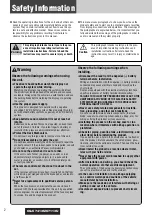
23
INSTALLATION— Continued
3. With the wires already connected to your speakers, now connect each wire to
the appropriate output terminal on your receiver or amplifier. Repeat this step for
each channel to be hooked up. Your receiver or amplifier will specify which ter-
minals are for which channels. Remember that the left and right front channels
are the speakers on your left and right when you are facing them. As before,
make sure that there are no loose wire strands that can make contact with an-
other wire or terminal.
4. Double check your wiring. In home theater systems there is a lot of wiring nec-
essary, making it easy to make a mistake (this happens to the best of us). We
highly suggest taking an extra moment to check each connection to make sure
all channels are in phase (see Phasing above).
The illustration above shows the rear of a typical 5.1 A/V receiver. Many cur-
rent receivers have 7.1 capability. You can use either a 5.1 or 7.1 A/V receiver with
your 5.1 system. We suggest you refer to your A/V receiver’s owners manual. It will
show you your receiver’s layout for your speaker connections. Some people will ask:
“What does the .1 mean in 5.1 and 7.1?” The number after the decimal place indi-
cates the number of subwoofers. A 5.1 system has 5 speakers plus one subwoofer.
A 7.1 system has 7 speakers plus 1 subwoofer. Taken further, a 7.2 system has 7
speakers plus 2 subwoofers.
With a 5.1 system, you will connect your front speakers to the left, right, and
center speakers to the appropriate speaker connectors. Obviously, the surround
speakers will be connected to the surround terminals. With a 7.1 system, you’ll con-
nect 2 additional speakers to the back or rear terminals.
5.1 And 7.1 System Installation
Summary of Contents for CG24 Monitor
Page 2: ......
















































